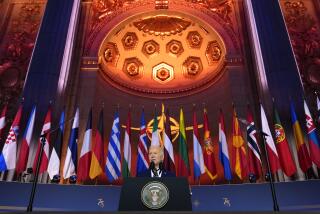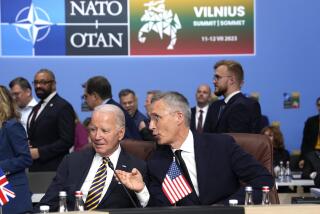Age-Old Schisms Define Entry to Western Alliance : NATO: The Christian elite’s disdain for the Orthodox and Muslim East is an impediment to building a modern Europe.
Americans need to understand that ancient cultural divisions underlie today’s military-strategic argument between the Clinton Administration and the East Europeans about where to “draw the line” in Europe, whether to bring Eastern European countries into the Atlantic Alliance (NATO) quickly.
Many of NATO’s Western European members also, especially the Germans, would prefer an alliance based on a simple--if always unspoken--principle that gives the European Union, formerly the European Community, its cultural identity: If your country is Roman Catholic or Protestant in heritage then you are suited for NATO membership sooner rather than later. But if yours is an Orthodox or Muslim nation you are not fit to be an alliance (or European Union) member now or probably ever.
All four of the Eastern European countries that have been pleading for quick admission into the alliance are fundamentally Catholic in their culture--Poland, Slovakia, Hungary and the Czech Republic. That historical tradition drives their present insistence that they be recognized as part of the West through rapid admittance into the NATO alliance. Russia and Ukraine, which the President visited after his stopovers in Brussels and Prague, belong to the Orthodox tradition.
Historical antecedents reaching back centuries lend powerful force to appeals by Poles, particularly, that the line between East and West be drawn once again, in 1994, where it was for so long before the two world wars. Division between Catholic and Orthodox Christianity in the eastern part of Europe and the Balkans, in fact, goes very far back indeed--to the great schism of 1054 between the bishop at Rome and the patriarch at Constantinople.
Age-old fears in modern guise about dangerous barbarians to the east and southeast thus resound in Polish President Lech Walesa’s call to Bill Clinton to help “cage the Russian bear” by letting Poland into NATO now. German Angst about hordes of Russian or Ukrainian refugees swarming across newly open frontiers best explains why German political leaders are the first to champion the Poles’ membership plea.
During late medieval times, when the Muslim sultans of Ottoman Turkey began to move northward into the Balkans and the Orthodox czars of Muscovite Russia westward across the steppes toward Warsaw, Catholics like the Poles, Hungarians and Croats perceived themselves as guardians upon the ramparts. To wealthy, comfortable and relatively safe Austrians, Germans and French, they depicted themselves as Catholic Christendom’s bulwark against the Muslim and Orthodox East.
Poles, Czechs, Slovaks and Hungarians have seldom since the Middle Ages been completely accepted as part of the Catholic Christian West, however. That has been tragically true right down until recently. Walesa and Czech President Vaclav Havel play upon the West’s historical guilt when they remind Paris, London and Washington that at least twice in this century, at Munich in 1938 and at Yalta in 1945, the West sold them out.
One of Germany’s most foresighted political leaders argues privately that post-Cold War Europe must group only those countries that experienced the Renaissance, Reformation, Counter-Reformation and Enlightenment--none of which, of course, put a stamp on Russia or Islam. Such deep-seated cultural attitudes among elites explain better than any strategic rationale why Western Europeans have tended until now to close their eyes to the slaughter of Muslim Bosnians and why they shudder at the U.S. Administration’s idea of one day bringing Russia into NATO.
Overtly defining NATO’s (or the EU’s) identity in cultural terms immediately raises many nasty foreign-policy problems. How, for example, do you justify excluding Catholic Lithuania or Croatia? Protestant Latvia or Estonia? Nobody will define that identity openly in such terms. But it remains below the surface the determinative factor nonetheless.
Quite apart from insoluble foreign-policy problems, the United States, where openness, diversity and multiculturalism are prized, needs to challenge its Western European allies about the long-term wisdom of excluding countries whose historical traditions differ from those of Western Europe. American policies of inclusion, rather than European ones of exclusion, may be right for modern Europe, not only strategically but culturally as well.
More to Read
Sign up for Essential California
The most important California stories and recommendations in your inbox every morning.
You may occasionally receive promotional content from the Los Angeles Times.










